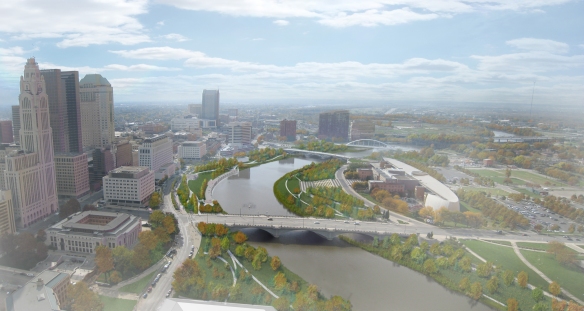Ohio’s three largest cities—Cleveland, Columbus, and Cincinnati—have devised strategic urban developments geared toward revamping their waterfronts, with aspirations of boosting local quality of life and economic growth.
Cleveland – Lakefront Development Plan

This past June, Cleveland City Council approved legislation for its long-anticipated lakefront development project. The primary objective is to enhance accessibility of the city’s waterfront.
Dick Pace of Cumberland TCC, LCC, the developer, is expected to build about 1,000 apartments, 80,000 square feet of commercial office space, and 40,000 square feet of retail and restaurant space on 21 acres of the lakefront. The construction will occur in phases so that each section of the new development complements construction taking place in the downtown.
The plan capitalizes on existing anchor institutions, such as the Rock and Roll Hall of Fame, the Great Lakes Science Museum, and the Browns stadium, to attract visitors to the lake and leaves space for future development—such as hotels, restaurants, and shops—as the phases of the project advance over time. While the city is funding portions of the project with public funds, the hope is that private investors will be drawn to the area and develop along the lakefront once the infrastructure is in place.
To accommodate affordable housing, Pace said that local public servants, such as teachers and police officers, who wish to live in the neighborhood will be granted reduced rent. He also mentioned that the project will honor a Community Benefits Agreement that assures that Pace will employ local apprentices from Cleveland’s Max Hayes High School and give homegrown firms a chance to work on the project.
Cleveland’s lakefront development project is strategically devised to generate more revenue, attract businesses, promote exposure, boost local quality of life, and increase the volume of tourism in the city.
Columbus – Scioto Greenways Project

Planning for the redevelopment of Columbus’ downtown riverfront has been underway for the past two decades, with exciting progress taking place within the last several years. In April of 2012, the City of Columbus and Franklin County—which are major land owners on the Scioto Peninsula—asked the Columbus Downtown Development Corporation to develop a strategic land use plan for the peninsula. The idea of the Scioto Greenways project was first introduced during the public process leading up to the generation of the 2010 Downtown Strategic Plan.
The Scioto Greenways project, which is estimated to cost $35.5 million and is being funded by numerous public and private partners, involves three primary components that will revamp the area around the river. Those three components are:
- removing the Main Street Dam,
- restoring the Scioto River channel, and
- creating 33 acres of new green space.
The Main Street Dam was removed in late 2013, restoring the natural flow of the river and improving the ecological systems and river habitat. The riverbanks and river channel are currently under construction, but once they are completed, they will provide new recreation options and the opportunity to build upon existing investments in the area through the creation of a stunning 33-acre greenway through downtown Columbus.
This project will better connect Downtown Columbus to the Scioto Peninsula and East Franklinton by expanding on recent park investment, creating links to the existing regional bikeway system, and catalyzing further private investment in the urban core.
Cincinnati – The Banks

Downtown Cincinnati’s riverfront between the Great American Ball Park and Paul Brown Stadium is in the midst of a transformation. The Banks development project is turning 18 acres of undeveloped riverfront land along the Ohio River into a dynamic mixed-use “Live, Work, Play” destination.
The Banks project is part of a riverfront strategic development plan that was originally unveiled in the ‘90s. The development will incorporate residential units, office space, as well as dining, leisure and entertainment venues and will connect Cincinnati’s downtown to the waterfront via a 45-acre Riverfront Park.
Atlanta-based companies Carter and The Dawson Company, along with their capital partner USAA Real Estate Company, have been leading the development as a joint venture since 2007. The City of Cincinnati partnered with Hamilton County to provide infrastructure for the site, including a multi-modal transit facility, parking garages, street grid improvements, and utilities.
In late 2009, Phase I construction began by adding luxury apartments and street-level restaurants that opened in 2011, and further street-level retail that opened throughout 2012 and 2013. Ongoing development, which will include more residential, retail, hotel and office sites, will be completed in phases throughout a ten to fifteen year time frame.
The project is expected to add around $600 million in investment and around 1,000 permanent jobs to the local economy, according to a recent study. Already, the development is attracting new national retailers and residents to Cincinnati, which demonstrates the power of waterfront redevelopment as an asset for local quality of life and economic growth.
The waterfront revitalization projects in Cleveland, Columbus and Cincinnati are expected to increase property values, encourage private investment, and contribute to vibrant communities, while improving connectivity between these cities and their beautiful water assets.


